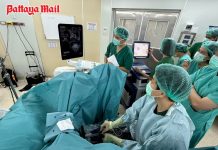The advances in cardiac surgery have been enormous over the past 20 years. We have gone from some fairly primitive high-risk surgery, to some very, very sophisticated interventional techniques, which have given cardiac patients a new lease of life. In fact, if the techniques that are available now, were able to be carried out 30 years ago, my father would in all probability, still be alive today.
However, before getting into modern life-saving techniques, a short review of cardiac pathology is in order. Myocardial infarction is the common cause of cardiac muscle death, and finally ours. (Make that “yours” as I’m not going yet!)
The heart muscle is supplied with oxygenated blood by its own system of arteries. The heart does not get its oxygen from the blood in its chambers. Instead, there is a network of ‘heart’ arteries (called the coronary arteries) which supply the cardiac muscle. If any of these get blocked, this is known as a “stenosis” or an “occlusion”, which in turn can bring on the coronary “conclusion”! The death of the muscle is called “infarction”.
The blockage is most often caused by Cholesterol, which gets deposited on the inside wall of the arteries and is called “plaque”, and then red cells stick on the surface of the deposit and it builds up from there. If you have a 50 percent stenosis, you will start to get chest pains on exercise. If you have a 100 percent stenosis, you may drop dead during the exercise.
To correct this problem, the only way we knew was to carry out an open heart operation, replace the blocked coronary arteries with vessels taken from other parts of the body, usually veins from the leg. However, now we can leave your arteries where they are, but do something to relieve the stenosis, or blockage. This is called “Angioplasty”.
One way is to send an inflatable balloon to dilate the blocked area, and this is known as coronary balloon angioplasty. It is more formally known as percutaneous transluminal coronary angioplasty (PTCA): percutaneous meaning “through the skin,” transluminal meaning “inside the blood vessel,” coronary meaning “related to the heart,” and angioplasty meaning “blood vessel repair.”
Angioplasty involves creating space in the blocked artery by inserting and inflating a tiny balloon, which compresses some of the blocking plaque against the arterial wall. When the balloon is deflated and removed, the plaque still remains compressed, clearing a space in the artery and improving blood flow. While angioplasty does not always completely clear an artery, more than 90 percent of all procedures are immediately successful.
There are other techniques available, and the most common is by using “stents”. This is called percutanous coronary intervention (PCI). The success in today’s cardiac surgery is due in part to the increased use of these tiny wire mesh tubes called stents, which cardiologists began using in the 1990s to help keep arteries open following angioplasty. About 70 to 90 percent of all angioplasty patients receive a stent, which is inserted permanently at the site of the blockage.
Stents can be used in a number of ways with angioplasty procedures. A stent may be inserted during an original angioplasty to prevent possible arterial collapse and lower the chance of heart attack and re-narrowing of the artery (called re-stenosis). A stent also may be inserted during a second angioplasty to prevent recurrent restenosis. Stents can also be used in the unlikely event that an artery is injured by the catheter. Experienced doctors are able to install stents in one or more arteries with a high probability of success.
The use of stents has decreased the abrupt and unpredictable closure of an artery, which necessitated emergency coronary artery bypass surgery. Studies show stents are better than angioplasty alone in preventing re-stenosis, which is one of the most common problems associated with angioplasty.
Evidence suggests that angioplasty patients are doing better today because doctors are better able to target blockages, by using such techniques as the 64 Slice CT, so your interventionist is able to pinpoint the blockage with greater accuracy. However, we will deal with the 64 Slice CT technology another week.




